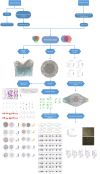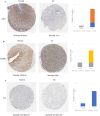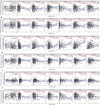Network pharmacology and experimental verification based research into the effect and mechanism of Aucklandiae Radix-Amomi Fructus against gastric cancer
- PMID: 35672352
- PMCID: PMC9174187
- DOI: 10.1038/s41598-022-13223-z
Network pharmacology and experimental verification based research into the effect and mechanism of Aucklandiae Radix-Amomi Fructus against gastric cancer
Abstract
To investigate the mechanism of the Aucklandiae Radix-Amomi Fructus (AR-AF) herb pair in treating gastric cancer (GC) by using network pharmacology and experimental verification. Using the traditional Chinese medicine system pharmacology database and analysis platform (TCMSP), the major active components and their corresponding targets were estimated and screened out. Using Cytoscape 3.7.2 software, a visual network was established using the active components of AR-AF and the targets of GC. Based on STRING online database, the protein interaction network of vital targets was built and analyzed. With the Database for Annotation, Visualization, and Integrated Discovery (DAVID) server, the gene ontology (GO) biological processes and the Kyoto Encyclopedia of Genes and Genomes (KEGG) signaling pathways of the target enrichment were performed. AutoDock Vina was used to perform molecular docking and calculate the binding affinity. The mRNA and protein expression levels of the hub targets were analyzed by the Oncomine, GEPIA, HPA databases and TIMER online tool, and the predicted targets were verified by qRT-PCR in vitro. Eremanthin, cynaropicrin, and aceteugenol were identified as vital active compounds, and AKT1, MAPK3, IL6, MAPK1, as well as EGFR were considered as the major targets. These targets exerted therapeutic effects on GC by regulating the cAMP signaling pathway, and PI3K-Akt signaling pathway. Molecular docking revealed that these active compounds and targets showed good binding interactions. The validation in different databases showed that most of the results were consistent with this paper. The experimental results confirmed that eremanthin could inhibit the proliferation of AGS by reducing the mRNA expression of hub targets. As predicted by network pharmacology and validated by the experimental results, AR-AF exerts antitumor effects through multiple components, targets, and pathways, thereby providing novel ideas and clues for the development of preparations and the treatment of GC.
© 2022. The Author(s).
Conflict of interest statement
The authors declare no competing interests.
Figures



























Similar articles
-
Network pharmacology based research into the effect and mechanism of Yinchenhao Decoction against Cholangiocarcinoma.Chin Med. 2021 Jan 21;16(1):13. doi: 10.1186/s13020-021-00423-4. Chin Med. 2021. PMID: 33478536 Free PMC article.
-
Unveiling the potential mechanisms of Amomi fructus against gastric ulcers via integrating network pharmacology and in vivo experiments.J Ethnopharmacol. 2024 Jan 30;319(Pt 2):117179. doi: 10.1016/j.jep.2023.117179. Epub 2023 Sep 29. J Ethnopharmacol. 2024. PMID: 37777029
-
Understanding apoptotic induction by Sargentodoxa cuneata-Patrinia villosa herb pair via PI3K/AKT/mTOR signalling in colorectal cancer cells using network pharmacology and cellular studies.J Ethnopharmacol. 2024 Jan 30;319(Pt 3):117342. doi: 10.1016/j.jep.2023.117342. Epub 2023 Oct 23. J Ethnopharmacol. 2024. PMID: 37879505
-
The mechanism of peach kernel and safflower herb-pair for the treatment of liver fibrosis based on network pharmacology and molecular docking technology: A review.Medicine (Baltimore). 2023 Apr 21;102(16):e33593. doi: 10.1097/MD.0000000000033593. Medicine (Baltimore). 2023. PMID: 37083803 Free PMC article. Review.
-
Investigating the therapeutic mechanism of Xiaotan Sanjie Formula for gastric cancer via network pharmacology and molecular docking: A review.Medicine (Baltimore). 2023 Nov 17;102(46):e35986. doi: 10.1097/MD.0000000000035986. Medicine (Baltimore). 2023. PMID: 37986339 Free PMC article. Review.
Cited by
-
Integrating network pharmacology, molecular docking, and bioinformatics to explore the mechanism of sparganii rhizoma in the treatment of laryngeal cancer.Mol Divers. 2025 Feb 26. doi: 10.1007/s11030-025-11142-5. Online ahead of print. Mol Divers. 2025. PMID: 40009149
-
Inhibiting AGS Cancer Cell Proliferation through the Combined Application of Aucklandiae Radix and Hyperthermia: Investigating the Roles of Heat Shock Proteins and Reactive Oxygen Species.Antioxidants (Basel). 2024 May 3;13(5):564. doi: 10.3390/antiox13050564. Antioxidants (Basel). 2024. PMID: 38790669 Free PMC article.
-
Quality identification of Amomi fructus using E-nose, HS-GC-IMS, and intelligent data fusion methods.Front Chem. 2025 Feb 6;13:1544743. doi: 10.3389/fchem.2025.1544743. eCollection 2025. Front Chem. 2025. PMID: 39981266 Free PMC article.
-
The Abundant Phytocannabinoids in Rheumatoid Arthritis: Therapeutic Targets and Molecular Processes Identified Using Integrated Bioinformatics and Network Pharmacology.Life (Basel). 2023 Mar 5;13(3):700. doi: 10.3390/life13030700. Life (Basel). 2023. PMID: 36983855 Free PMC article.
-
A Comprehensive Study to Investigate the Tumor-Suppressive Role of Radix Bupleuri on Gastric Cancer with Network Pharmacology and Molecular Docking.Drug Des Devel Ther. 2024 Feb 8;18:375-394. doi: 10.2147/DDDT.S441126. eCollection 2024. Drug Des Devel Ther. 2024. PMID: 38347958 Free PMC article.
References
-
- Le X, Mu J, Peng W, Tang J, Xiang Q, Tian S, Feng Y, He S, Qiu Z, Ren G, et al. DNA methylation downregulated ZDHHC1 suppresses tumor growth by altering cellular metabolism and inducing oxidative/ER stress-mediated apoptosis and pyroptosis. Theranostics. 2020;10(21):9495–9511. doi: 10.7150/thno.45631. - DOI - PMC - PubMed
Publication types
MeSH terms
Substances
LinkOut - more resources
Full Text Sources
Medical
Research Materials
Miscellaneous

